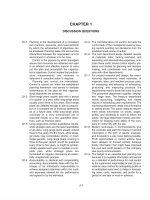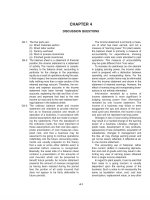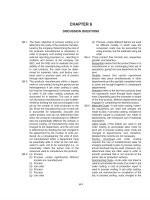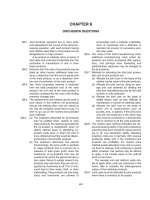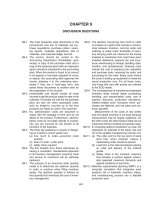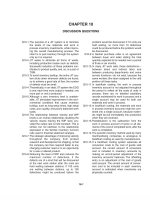Solution manual cost accounting by carter 14e ch02
Bạn đang xem bản rút gọn của tài liệu. Xem và tải ngay bản đầy đủ của tài liệu tại đây (40.67 KB, 14 trang )
CHAPTER 2
DISCUSSION QUESTIONS
Q2-1. (a) Cost is the current monetary value of
economic resources given up or to be
given up in obtaining goods and services.
Economic resources may be given up by
transferring cash or other property,
issuing capital stock, performing services,
or incurring liabilities.
Costs are classified as unexpired or
expired. Unexpired costs are assets and
apply to the production of future revenues. Examples of unexpired costs are
inventories, prepaid expenses, plant and
equipment, and investments. Expired
costs, which most costs become eventually, are those that are not applicable to
the production of future revenues and are
deducted from current revenues or
charged against retained earnings.
Expense in its broadest sense includes
all expired costs; i.e., costs which do not
have any potential future economic benefit.
A more precise definition limits the use of
the term “expense” to the expired costs
arising from using or consuming goods and
services in the process of obtaining revenues; e.g., cost of goods sold and marketing and administrative expenses.
(b) (1) Cost of goods sold is an expired cost
and may be referred to as an expense in
the broad sense of the term. On the
income statement, it is most often identified as a cost. Inventory held for sale
which is destroyed by an abnormal
casualty should be classified as a loss.
(2) Uncollectible accounts expense is usually classified as an expense. However,
some authorities believe that it is more
desirable to classify uncollectible accounts
as a direct reduction of sales revenue (an
offset to revenue). An uncollectible account
which was not provided for in the annual
adjustment, such as bankruptcy of a major
debtor, may be classified as a loss.
(3) Depreciation expense for plant machinery is a component of factory overhead
and represents the reclassification of a
portion of the machinery cost to product
cost (inventory). When the product is sold,
the depreciation becomes a part of the
cost of goods sold which is an expense.
Depreciation of plant machinery during an
unplanned and unproductive period of idleness, such as during a strike, should be
classified as a loss. The term “expense”
should preferably be avoided when making
reference to production costs.
(4) Organization costs are those costs
that benefit the firm for its entire period of
existence and are most appropriately
classified as a noncurrent asset. When
there is initial evidence that a firm’s life is
limited, the organization costs should be
allocated over the firm’s life as an
expense or should be amortized as a loss
when a going concern foresees termination. In practice, however, organization
costs are often written off in the early
years of a firm’s existence.
(5) Spoiled goods resulting from normal
manufacturing processing should be
treated as a cost of the product manufactured. When the product is sold, the cost
becomes an expense. Spoiled goods
resulting from an abnormal occurrence
should be classified as a loss.
Q2-2. Cost objects are units for which an arrangement is made to accumulate and measure
cost. They are important because of the need
for multiple dimensions of data (e.g., by product, contract, or department) to accomplish
the various purposes of cost accounting,
including cost finding, planning, and control.
Q2-3. (a) To classify costs as direct or indirect, the
cost accountant must first know the
answers to the questions “Directly traced
to what?” and “Indirectly identified with
what?” Otherwise, there is no way to
assess the direct or indirect nature of a
cost. It is the choice of a cost object that
answers those two questions.
(b) For example, the cost of a department
manager’s salary cannot be classified as
2-1
2-2
direct or indirect without selecting the
cost object first. If the cost object is a
product unit produced in the manager’s
department, then the salary is indirect. If
the cost object is the department, the
salary is direct.
Q2-4. (a) The product unit, batch, or lot is the cost
object. (Be careful about the lack of
clarity of t������������������������������������������������������������������������������������������������������������������������������������������������������������������������������������������������������������������������������������������������������������������������������������������������������������������������������������������������������������������������������������������������������������������������������������������������������������������������������������������������������������������������������������������������������������������������������������������������������������������������������������������������������������������������������������������������������������������������������������������������������������������������������������������������������������������������������������������������������������������������������������������������������������������������������������������������������������������������������������������������������������������������������������������������������������������������������������������������������������������������������������������������������������������������������������������������������������������������������������������������������������������������������������������������������������������������������������������������������������������������������������������������������������������������������������������������������������������������������������������������������������������������������������������������������������������������������������������������������������������������������������������������������������������������������������������������������������������������������������������������������������������������������������������������������������������������������������������������������������������������������������������������������������������������������������������������������������������������������������������������������������������������������������������������������������������������������������������������������������������������������������������������������������������������������������������������������������������������������������������������������������������������������������������������������������������������������������������������������������������������������������������������������������������������������������������������������������������������������������������������������������������������������������������������������������������������������������������������������������������������������������������������������������������������������������������������������������������������������������������������������������������������������������������������������������������������������������������������������������������������������������������������������������������������������������������������������������������������������������������������������������������������������������������������������������������������������������������������������������������������������������������������������������������������������������������������������������������������������������������������������������������������������������������������������������������������������������������������������������������������������������������������������������������������������������������������������������������������������������������������������������������������������������������������������������������������������������������������������������������������������������������������������������������������������������������������������������������������������������������������������������������������������������������������������������������������������������������������������������������������������������������������������������������������������������������������������������������������������������������������������������������������������������������������������������������������������������������������������������������������������������������������������������������������������������������������������������������������������������������������������������������������������������������������������������������������������������������������������������������������������������������������������������������������������������������������������������������������������������������������������������������������������������������������������������������������������������������������������������������������������������������������������������������������������������������������������������������������������������������������������������������������������������������������������������������������������������������������������������������������������������������������������������������������������������������������������������������������������������������������������������������������������������������������������������������������������������������������������������������������������������������������������������������������������������������������������������������������������������������������������������������������������������������������������������������������������������������������������������������������������������������������������������������������������������������������������������������������������������������������������������������������������������������������������������������������������������������������������������������������������������������������������������������������������������������������������������������������������������������������������������������������������������������������������������������������������������������������������������������������������������������������������������������������������������������������������������������������������������������������������������������������������������������������������������������������������������������������������������������������������������������������������������������������������������������������������������������������������������������������������������������������������������������������������������������������������������������������������������������������������������������������������������������������������������������������������������������������������������������������������������������������������������������������������������������������������������������������������������������������������������������������������������������������������������������������������������������������������������������������������������������������������������������������������������������������������������������������������������������������������������������������������������������������������������������������������������������������������������������������������������������������������������������������������������������������������������������������������������������������������������������������������������������������������������������������������������������������������������������������������������������������������������������������������������������������������������������������������������������������������������������������������������������������������������������������������������������������������������������������������������������������������������������������������������������������������������������������������������������������������������������������������������������������������������������������������������������������������������������������������������������������������������������������������������������������������������������������������������������������������������������������������������������������������������������������������������������������������������������������������������������������������������������������������������������������������������������������������������������������������������������������������������������������������������������������������������������������������������������������������������������������������������������������������������������������������������������������������������������������������������������������������������������������������������������������������������������������������������������������������������������������������������������������������������������������������������������������������������������������������������������������������������������������������������������������������������������������������������������������������������������������������������������������������������������������������������������������������������������������������������������������������������������������������������������������������������������������������������������������������������������������������������������������������������������������������������������������������������������������������������������������������������������������������������������������������������������������������������������������������������������������������������������������������������������������������������������������������������������������������������������������������������������������������������������������������������������������������������������������������������������������������������������������������������������������������������������������������������������������������������������������������������������������������������������������������������������������������������������������������������������������������������������������������������������������������������������������������������������������������������������������������������������������������������������������������������������������������������������������������������������������������������������������������������������������������������������������������������������������������������������������������������������������������������������������������������������������������������������������������������������������������������������������������������������������������������������������������������������������������������������������������������������������������������������������������������������������������������������������������������������������������������������������������������������������������������������������������������������������������������������������������������������������������������������������������������������������������������������������������������������������������������������������������������������������������������������������������������������������������������������������������������������������������������������������������������������������������������������������������������������������������������������������������������������������������������������������������������������������������������������������������������������������������������������������������������������������������������������������������������������������������������������������������������������������������������������������������������������������������������������������������������������������������������������������������������������������������������������������������������������������������������������������������������������������������������������������������������������������������������������������������������������������������������������������������������������������������������������������������������������������������������������������������������������������������������������������������������������������������������������������������������������������������������������������������������������������������������������������������������������������������������������������������������������������������������������������������������������������������������������������������������������������������������������������������������������������������������������������������������������������������������������������������������������������������������������������������������������������������������������������������������������������������������������������������������������������������������������������������������������������������������������������������������������������������������������������������������������������������������������������������������������������������������������������������������������������������������������������������������������������������������������������ cost ...........................
$3,000 (given)
2,000 (given)
$1,000
Direct labor cost = 1/2 of direct material cost
= 1/2 × $1,000 = $500
Conversion cost .............................................
Less direct labor cost....................................
Equals overhead cost ....................................
$2,000 (given)
500 (calculated above)
$1,500
E2-9
(1)
The relevant cost objects are:
(a) An item of merchandise.
(b) The use of a bank credit card.
(2)
It implies that cash-paying customers are paying a part of the cost of the banks’
fees for processing credit card transactions, because these fees are paid by the
merchant who then recovers them in the form of slightly higher prices for all
merchandise.
(3)
The competitive implications are that the prices paid by cash customers are too
high to be competitive with the prices charged by merchants who deal only in
cash, and the prices paid by customers using bank credit cards are too low to
reflect all the costs of a credit sale.
(4)
The reason for not reducing all prices and charging extra for the use of a credit
card is because of the psychological effect of an extra charge. To customers, it
sounds like a penalty, as if the merchant wants to discourage the use of bank
credit cards. A discount for cash customers has a positive connotation, even if
prices marked on merchandise are higher to begin with. Raising all prices and
offering a cash discount yields the same net revenue as leaving prices alone and
charging extra for using a bank credit card, but the former method feels better to
the customer than the latter.
2-8
Chapter 2
E2-10
(1)
The relevant cost objects are:
(a) A repair.
(b) A pickup and delivery.
(2)
JTRS’s repair prices include an allocation of the cost of picking up and delivering tractors, in addition to the cost of the repairs, administrative costs, marketing costs, and profit. Competitors’ repair prices reflect only the cost of the
repairs, administrative and marketing costs, and profit. Competitors should be
able to price their repair services lower, because they do not have to reflect
pickup and delivery costs in repair prices.
E2-11
(1)
Direct labor...................................................................................... $ 2
Variable factory overhead..............................................................
5
Fixed factory overhead ..................................................................
4
Conversion cost.............................................................................. $11
(2)
Direct material (lumber) ................................................................. $12
Direct labor......................................................................................
2
Prime cost ....................................................................................... $14
(3)
Direct material (lumber) ................................................................. $12
Direct labor......................................................................................
2
Variable factory overhead..............................................................
5
Variable manufacturing cost ......................................................... $19
(4)
Direct material (lumber) ................................................................. $12
Direct labor......................................................................................
2
Variable factory overhead..............................................................
5
Variable marketing..........................................................................
1
Total variable cost .......................................................................... $20
Chapter 2
2-9
E2-11 (Concluded)
(5)
Total cost = total variable manufacturing cost
+ total variable marketing cost
+ total fixed cost
= 2,000 × ($12 + $2 + $5)
+ 1,900 × $1
+ 2,000* × ($4 + $3)
= $38,000 + $1,900 + $14,000
= $53,900
*The volume used here to calculate total fixed cost is the 2,000-unit volume level
that was used originally to calculate the amounts of fixed costs per unit, as
stated in the data given in the exercise. The 2,000-unit level of production stated
in requirement (5) is not the reason that 2,000 is used here to calculate total fixed
cost.
(6)
The data indicate the bookcases are made of lumber, and some examples of the
indirect materials used in making wooden bookcases would be glue, sandpaper,
and nails.
(7)
An estimate of costs referred to in the answer to requirement (6) would be
included in the variable factory overhead of $5 per unit.
E2-12 Factory overhead
Total
manufacturing
cost
=
1/3 × prime cost, so:
=
prime cost + factory overhead
=
prime cost + (1/3 × prime cost)
=
4/3 × prime cost;
multiplying both sides by 3/4 gives:
Total
3/4 × manufacturing
cost
3/4 × $20,000
$15,000
=
3/4 × 4/3 × prime cost
= 1 × prime cost
= prime cost.
Prime cost.........................................................................
Less direct material cost.................................................
Direct labor cost...............................................................
$15,000
12,000 (given)
$ 3,000
2-10
Chapter 2
E2-13 APPENDIX
1.
2.
3.
4.
5.
6.
7.
8.
9.
10.
11.
12.
13.
GL (This is a measure of information systems.)
GL
C
IBP
F
IBP
F
F
IBP (This measure and the next one are measures of innovation, which is part
of the internal business process perspective.)
IBP
C
GL
GL
Chapter 2
2-11
CASES
C2-1
(1)
The percentage profit margin will be 82.5%, calculated as follows:
Revenues ($2 × 4) .....................................
Cost of juice ($.20 × 4) .............................
$.80
Cost of one delivery .................................
.60
Profit...........................................................
$8.00
1.40
$6.60
Percentage profit margin = $6.60 profit divided by $8 revenue = 82.5%.
(2)
The percentage profit margin will be 60%, calculated as follows:
Revenues ($2 × 1) .....................................
Cost of juice ($.20 × 1) .............................
$.20
Cost of one delivery .................................
.60
Profit...........................................................
$2.00
.80
$1.20
Percentage profit margin = $1.20 profit divided by $2 revenue = 60%.
(3)
The manager is treating the menu item as the cost object, for example, one
glass of orange juice.
(4)
The refinement of the definition of cost object that would result in the planned
profit margin is the use of two different kinds of cost object, the item and the
delivery, which can be priced separately at $.80 and $2.40, respectively.
2-12
Chapter 2
C2-1 (Concluded)
(5)
For an order consisting of four glasses of orange juice, the profit margin will be
75%, calculated as follows:
Revenues:
($.80 × 4) ...........................
+ ($2.40 × 1) .........................
Cost of juice ($.20 × 4) .............................
Cost of one delivery .................................
Profit...........................................................
$3.20
2.40
$5.60
$.80
.60
1.40
$4.20
Percentage profit margin = $4.20 profit divided by $5.60 revenue = 75%.
For an order consisting of one glass of orange juice, the profit margin will also
be 75%, calculated as follows:
Revenues:
($.80 × 1) ...........................
+ ($2.40 × 1) .........................
Cost of juice ..............................................
Cost of one delivery .................................
Profit...........................................................
$ .80
2.40
$3.20
$.20
.60
.80
$2.40
Percentage profit margin = $2.40 profit divided by $3.20 revenue = 75%.
(6)
The food service manager’s plan allocates the delivery costs over an arbitrarily
selected number of items (two). This plan would result in higher-than-planned
profit margin percentages on room service orders that contain more than two
items, as demonstrated in the answer to requirement (1). Prices on these orders
would be higher than those of a competitor who traces costs more carefully to
cost objects and sets prices accordingly. The plan would also result in lowerthan-planned profit margins on room service orders containing only one item,
as demonstrated in the answer to requirement (2). Prices on these orders would
be lower than what is needed to achieve the target profitability.
Chapter 2
2-13
C2-2
(1)
The cost objects for which some amount of cost is identified in the case, and the
amount of cost identified for each, are:
(a) A new product variation, Zeggo (which means all units of Zeggo ever to be
produced), $250,000.
(b) A batch of Zeggo, $1,000.
(c) A unit of Zeggo, $5 + $10 = $15. (Notice the $10 indirect cost amount includes
all indirect production costs, so it must include the $1 amount stated in the
problem, along with an allocation or averaging of the $1,000-per-batch setup
costs, a share of the $250,000 cost amount, and a share of any other indirect
manufacturing costs. It would be double-counting to add the $1 and arrive
at a total of $16 per unit.)
(2)
The other items mentioned in the case that could serve as cost objects, and a
purpose each one could serve, are:
(a) CCN Company, which is the relevant cost object when external financial
statements are prepared.
(b) The assembly line on which Zeggo and other products are to be produced.
This cost object would be relevant in a decision on whether to discontinue
production of all the products produced on the particular line, or a decision
to shut down the line and shift its production to other lines due to a reduction in customer orders.
(3)
The total cost expected to result from producing the first batch of 300 units of
Zeggo is:
Cost accounted for as direct cost of a unit ......
$
5
Cost treated as indirect by the CCN system ....
1
$
6
× 300 units
$1,800
Add: setup cost ...................................................
1,000
Total cost ..............................................................
$2,800
(4)
The cost expected to result from producing one more unit of Zeggo is
$5 + $1 = $6.
(5)
For the first batch of 300 units, the CCN cost accounting system will report a
cost of:
($5 direct cost + $10 indirect cost allocation) × 300 units = $15 × 300 = $4,500
2-14
Chapter 2
C2-2 (Concluded)
(6)
For the one additional unit, the CCN cost accounting system will report a cost of
$5 + $10 = $15
(7)
The additional costs allocated by the CCN accounting system are of two types:
(a) Costs caused by activities other than the production of product units. Two
examples of these activities are mentioned in the problem: setting up the
assembly line and perfecting new product variations. Other activities would
include maintaining the assembly line and the department, ordering and
inspecting raw materials, training newly hired workers, maintaining a cost
accounting system, and expediting rush orders. (These are related to total
volume in the long run; therefore, most accounting systems classify them as
variable overhead, but they are unrelated to the production of a single unit
or batch of product.)
(b) Fixed costs that are incurred regardless of whether activities are carried out,
such as plant depreciation, insurance, and property taxes. These are the
costs of having capacity, not of using it.
